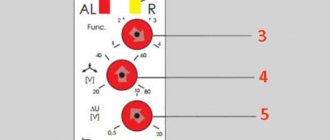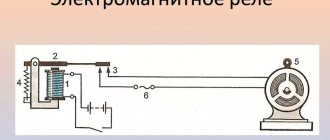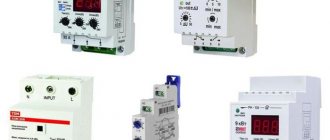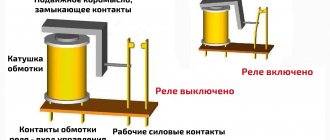Those houses that are connected to old power lines are acutely affected by power surges in the network. Due to such violations, household appliances often break down. The problem can be solved by simply installing a voltage relay. Let's analyze what such a device is and how to choose it wisely. We’ll also figure out how to connect the device to your home network.
Control device in a niche Source hsto.org
Why do you need to control voltage?
The device has an official name - voltage control relay. But the middle word is often discarded. And professionals often call the device among themselves “zero break protection.” After all, it falls into the category of protective automation. Let's figure out why we need a voltage relay.
The average consumer is accustomed to the fact that all electrical appliances are powered from a network whose voltage is 220 V. In fact, the voltage variation in the outlet is allowed with a plus or minus of 10 units. And all household equipment is produced so that it can work with a reserve. That is, in the range from 170 to 265 V.
But worn-out electrical networks sometimes produce spikes of up to 380 volts. Or they experience a voltage drop of up to 70 units. In both cases, nothing good happens. With an extreme instantaneous increase in parameters, in houses equipped with automatic protective equipment, the fuses will simply blow out. And if the latter are absent, then the action scenario can go in two ways.
Burnt fuse Source p-advice.com
Fuses will blow if there are any in a working TV, computer or microwave. In their absence, any device is guaranteed to fail if it was used at that moment. Moreover, it could easily catch fire. And this is already fraught with a fire in the house.
It would seem that too low voltage in the network cannot threaten anything terrible. Well, the light bulb in the lamp will burn dimly. Or the iron will not heat up and things will remain unironed. But this is not true.
First of all, all household appliances that have a compressor will suffer. The latter simply will not start at low voltage. This is fraught with the fact that the electric motors of the equipment quickly begin to overheat. And having reached a critical state, they completely fail.
See also: Catalog of companies that specialize in complex installation of internal engineering systems
Checking pH using a multimeter
Full tests can be carried out using special equipment in an electrical laboratory. However, the accuracy of the output voltage readings can be checked with a conventional multimeter. The device must be switched to the mode for measuring alternating voltage up to 700 V. This is indicated on the switch as “ACV 700”.
Then use a multimeter to determine the voltage at the output of the LV and compare this value with the readings on the display of the protective device. You need to understand that both devices have some measurement error. The readings should be approximately the same. A difference of 2-3 V is not a reason to panic. But if the differences are more significant, then there is a malfunction in the launch vehicle.
The use of LV will protect household electrical appliances from voltage surges. To do this, you will need to select the correct settings for its operation. Approximate values can be found in the device data sheet.
The voltage control relay is selected taking into account the number of supply phases and the maximum power of the consumer. It is advisable to purchase a protective device with a current reserve of 20-30%. If you need to control the current consumption, it is better to install a device with a built-in ammeter.
Causes of problems
There are three factors that cause voltage drop:
- When the phase is shorted to neutral, 380 Volts will appear in the socket.
- If a zero break occurs and the load in the network is low, then the voltage will sharply tend to the peak.
- There may be a voltage imbalance in the phases.
In the latter case, an unevenly distributed load leads to the fact that the busiest line will suffer. The voltage will drop to critical. And this is fraught with local problems in the technology itself. And, as a rule, if there is no surge protection relay on the line, then the refrigerator or air conditioner will be the first to suffer.
In rare cases, electricians are to blame for a zero break. The wire can be damaged due to inexperience and carelessness. More often the latter fades away from old age. The provided protection will de-energize the line and disastrous consequences will not occur. There will be temporary inconvenience until the network is restored.
But, if there is no voltage cut-off, then a real mess ensues in the house. In some rooms, the voltage in sockets drops to 50-100 units. In other apartments it rises sharply to 300-350. Moreover, the result is completely local and depends on the specific load on the home line.
A sharp increase in voltage Source uk-parkovaya.ru
As a result, some owners' household equipment simply stops working. Those less fortunate will have to take it for repairs. But after a critical power surge, it happens that repairing the device becomes unprofitable. And then all that remains is to buy a new one. And, as a rule, there is no one to file a claim with.
Why is it necessary to install such a relay?
If power lines in the private sector are damaged. If the line wire closes with the neutral, then the voltage in the house, instead of the usual 220V, will rise to 380V;
- A broken neutral wire is a fairly common occurrence. Ultimately, one phase will be significantly overloaded, while the other remains in passive mode.
- The voltage on one of the phases becomes approximately equal to 380V. Under such circumstances, the “life” of household appliances is on the brink;
- In the case when the transformer substation (transformer substation) is located far from the house, then, accordingly, the voltage will drop to an unacceptably low level;
- When a powerful consumer appears in the network, it significantly overloads one of the phases, and a imbalance occurs in the three-phase distribution system.
- The result is a burnt-out electric motor of the device.
How protection works
The operating principle of a voltage relay is simple. The device has a built-in network load monitoring unit. Control parameters are usually set by the manufacturer. But the owner has the right to set his own limits.
The block is constantly busy measuring the voltage on the line. And if it deviates from the norm in any direction, then a signal is instantly sent to the executive module. The latter immediately switches off the load on the line, saving working devices.
But the measuring unit continues to operate in cyclic mode. After a certain period of time, the module takes readings from the line. If violations persist, then the automation is inactive. She waits for the next time period for measurements.
Voltage monitoring device Source prom.st
It can also be installed manually. Or leave the factory settings. When the measurements show the specified norm, the executive unit is also notified about this. And it closes the power contact, renewing the connection to external power sources.
Phase control relay Schneider
The Schneider company is considered one of the best manufacturers of devices in the electrical power industry. The products of this company are actively used both at civilian sites and in large industrial organizations.
The advantages of the company's products include a flexible pricing policy, high quality and special conditions for customers.
The company produces circuit breakers, fuses, load switches and switchboard equipment.
In addition, the Schneider plant produces relays, switches, sockets, contactors and many other devices.
Popular models include relays:
- Control of 1-phase voltage (from 65 to 260 V and time delay from 0.1 to 10 s - RM17UBE
- 3-phase voltage control (208 to 480 V) - RM17TE
- 1-phase voltage control (160 to 280 V, 30 second delay) - EZ9C
- 3-phase voltage control (from 208 to 480 V) - RM17TT00 and others.
Selection of protective automation
Overvoltage relays can be classified according to three criteria. Pay attention to the location and dimensions. Take into account the capabilities of the device. As well as the number of phases in the electrical network. Due to these indicators, the installation of the device differs in many ways.
And when choosing protective automation, people usually pay attention to:
- operating range in volts;
- maximum power;
- passing current;
- speed of network shutdown when an alarm signal is given;
- delay before re-supplying electricity;
- presence of indication.
An important factor is the presence of manual settings. Many apartment owners are not satisfied with the parameters set by manufacturers. And they would like to independently set the upper and lower thresholds for triggering the automation.
Adjustable voltage control relay Source prom.st
Phasing
Since the power supply system may differ, the devices are divided into single-phase voltage control relays and three-phase ones. Apartments and most private cottages are equipped first. They work with networks with a voltage of 220 V.
Three-phase protection is mainly used in industry. For example, they protect machines that use several phases for their operation. Moreover, in some cases, phase synchronization is additionally controlled.
Three-phase relays are also used in private homes if the voltage circuit has 380 Volts. But the device has a feature that has a negative effect when used at home. The protection is triggered if oscillation occurs in any of the three phases, which is not critical on a private line. But for production, such a safety net is often a plus. Although in many cases you can easily do without it.
Recommendations for selection
From the above it follows that there are many types of voltage control relays. The selection is carried out taking into account the specific situation in which the RN will have to work. The most significant criteria for choosing a voltage monitoring relay are:
- Single-phase or three-phase network. An option is practiced when instead of one three-phase relay, 3 single-phase ones are installed.
- Relay type. Plug-in, designed for 1-3 consumers. They can withstand current up to 16 A. Modifications for DIN rail are more powerful. Through them it is possible to connect the entire apartment. The current passed is 40-80 A.
- Permissible relay current. For an ordinary apartment, a device capable of passing 30-40 A is suitable. This current is greater than the cross-section of household wiring will allow, but it is better to take the LV with a power reserve of 1.5-2 times. This way the device will last much longer.
- If a relay is purchased to connect a single household appliance, then before purchasing you should find out what its current consumption is. In this situation, it is enough to make a reserve of 30-50%.
Additional Information. There are voltage monitoring relays equipped with a built-in ammeter. These devices allow you to monitor the current consumed by the apartment. They can be used to provide protection against short circuits or network overloads.
Video description
The video will show how a single-phase voltage relay works, which one is better to choose based on the test results:
Device dimensions
All products are divided into 3 types:
- Adapter for one socket. Protects only one device connected through it.
- An extension cord where there can be from one to six sockets. In this case, the protection extends to an entire group of devices.
- Bag holder for DIN rail. It is mounted in a common electrical panel and controls the entire electrical supply system of the apartment.
The latest version of a 220 V voltage relay for the home is not only the most functional. It is also the most suitable in terms of design, since all devices are hidden from view. And the devices from the first two points most often have large sizes. And most often it is not possible to make them more compact so that they do not spoil the interior of the home.
Basics and additional features
In most modern protective automatic equipment, voltage control is carried out by a microprocessor. Cheap analogues of relays operate on the basis of a conventional comparator. The microprocessor allows for precise adjustment of the device. Including stepless manual adjustment for response thresholds.
Surge protection device Source psk-remont.ru
Also, devices may have different indications. In simple designs, only a pair of LEDs are built in, which indicate the voltage at the output and input. All modern models have a display on the body that shows the voltage. It can also show specified response thresholds.
Technical specifications
The main characteristics of the LV include operating voltage, number of connected phases and maximum throughput power. Below are the parameters of one of the popular relays - RV-32.
| Characteristic | Meaning |
| Supply voltage | 220 V |
| Maximum active power of the consumer | 7 kW |
| Load current limit | 32 A |
| Measurement error | +/-1 % |
| Degree of protection against dust and moisture | IP20 |
| Number of relay operating cycles | 100 thousand |
| Working temperature | from -5 to +40°C |
| Limit cross-section of connected wires | 6 sq. mm |
From the characteristics it follows that the relay is powered by a mains voltage of 220 V. The internal contacts are capable of continuously passing a current of 32 A, which corresponds to a consumer with a power of 7 kW. IP class 20 says the device is not suitable for use in wet areas or outdoors. It can be installed in a special electrical panel. 100 thousand operating cycles is the number of switching on and off of the relay that it can withstand without destruction.
Voltage relay DigiTOP Vp-50A IP20
Available connection diagrams
In the panel, a single-phase voltage relay is mounted after the meter. It must be placed in the break of the phase wire. Because only the device should control the voltage. And cut off the phase if necessary.
There are two connection diagrams. It is more common to install relays under direct load. But you can connect an additional magnetic contactor to it. When installing the device, the main thing is not to confuse the connection of wires to the input and output. True, this is difficult to do, since there are only three terminals on the automation body, and they are all labeled - input, zero, output.
Devices with different rated power are available for sale. Therefore, there will be no problems in selecting the right one for your home network. But it is always possible to install several low-power relays using a parallel circuit. In this case, only its own group of electrical appliances is connected to each controller.
Combined relay and contactor installation
An additional contactor is installed when the switching currents are too high. Often installing a relay together with a contactor is cheaper than purchasing an RKN that will match the parameters of the electron flow.
In this case, there is a requirement for the rated current of the control element: it must exceed the value at which the contactor operates. The latter will completely take over the current load.
This connection option has one, but quite significant, drawback: low performance. This is because the time required for the contactor to react is added to the milliseconds required for the control to operate. Based on this, when choosing both devices, you should pay attention to the maximum possible speed of each of them.
When connecting this harness, the phase wire from the VA is connected to a normally open contact.
This is the contactor circuit input. The phase input of the RKN must be connected with a separate cable. It can be connected to the contactor input terminal or BA output terminal.
Since the phase input of the control element is connected to a wire of a smaller cross-section, it is necessary to pay attention to the reliability of the connection. To prevent it from falling out of the socket where the thicker cable is located, both wires must be twisted and secured by soldering or crimped with a special sleeve.
When installing, make sure the corresponding wire for the relay is securely fastened. To connect the RKN output to the contactor solenoid terminal, use a cable with a diameter of 1–1.5 mm2. The zero of the control element and the second output of the coil are connected to the zero bus.
The contactor output is connected to the distribution bus via a phase power wire.
How to set up devices
The simplest designs have preset response thresholds set by default by the manufacturer. As a rule, the operating range of the relay is from 170 to 265 V. The parameters may differ, so when choosing, you need to pay attention to them, since it will not be possible to reconfigure later.
Adjustable relays have 3 settings:
- The lower threshold for triggering is set.
- The maximum voltage value is selected.
- Sets the delay period before turning on again.
Connecting a voltage relay is a serious process. But setup requires even more responsibility. It is necessary to study all the household equipment used in the house. And only then set the thresholds. As for turn-on delays, a compromise will have to be found there.
If appliances with a compressor (refrigerator, air conditioner) have priority in protection, then the voltage re-supply time must be set to quite long. From a couple of minutes. And in some cases even bring it to five. This will protect the devices from sudden voltage surges.
Extension cord with controller Source prom.st
But if only a TV and a computer are protected, then a delay of only 10-20 seconds is sufficient. For adjustments, smooth regulators are provided on the body. Modern devices are equipped with convenient sensors.
Some experts recommend connecting a voltage stabilizer rather than a control relay. This is motivated by the fact that in addition to the functions of the latter, it also equalizes the voltage. Therefore, more reliable protection is obtained.
But the stabilizer has significant disadvantages:
- It makes noise when working.
- Takes up a lot of space due to its bulkiness.
- Does not allow fine tuning.
- Increases the network current and thereby creates a danger for unprepared wiring.
- If the grounding is broken, the voltage surge remains unattended.
- Its cost is much higher than a conventional relay.
Therefore, they are accustomed to using a voltage stabilizer only locally. For example, to protect only one refrigerator.
Types of ILV devices
All relay models that perform the functions of a voltage regulator are divided into single-phase and three-phase.
Single phase relay . Usually installed in cottages and apartments - nothing more is required in house panels.
In electrical panels of private and apartment buildings, single-phase relays are usually used in a compact design on a DIN rail (+)
Three-phase relay . Such RNAs are intended for industrial use. They are often used in protection circuits for three-phase machine tools. Moreover, if such a three-phase switch is required at the input of such complex equipment, then it is often chosen in a combined version with control not only of voltage, but also of phase synchronization.
The main disadvantage and at the same time advantage of a three-phase relay is the complete shutdown of power at the output when the voltage jumps even in one of the phase lines at the input. In industry this is only beneficial. But in everyday life, voltage fluctuations in one phase are often not critical, and the RKN takes and turns off the protected network.
In some cases, such highly reliable reinsurance is needed. However, in the vast majority of situations it is unnecessary.
By type and dimensions
The entire range of voltage relays is divided into three types:
- plug-socket adapters;
- extension cords with 1-6 sockets;
- compact “bags” for DIN rail.
The first two options are used to protect one specific electrical appliance or a group. They plug into a regular indoor outlet.
The third option is intended for installation in an electrical panel as part of the protective system of the electrical network of an apartment or cottage.
Image gallery
Photo from
Regulator with extension cord
Three-phase relay for heavy-duty lines
Relay for installation in an electrical panel
Relay adapter for connection via a socket
The adapters and extensions of the regulators in question are quite large. Manufacturers try to make them as small as possible so that they do not spoil the interior with their appearance.
But the internal components of the voltage relay have their own rigid dimensions, and they also need to be arranged in one housing with a socket and plug. In terms of design, you can't turn around here.
Relays on a DIN rail for installation in a distribution panel have more compact dimensions, there is nothing superfluous in them. They are connected to the network by connecting wires and terminals.
By base and additional functions
The internal logic and operation of the relay for voltage control are built on the basis of a microprocessor or a simpler comparator. The first option is more expensive, but involves more accurate and smooth adjustment of the ILV response thresholds. Most of the protective devices sold are now microprocessor-based.
The upper (Umax) and lower (Umin) thresholds are the two main adjustable parameters of the RKN - if the input voltage is outside the set range, the relay disconnects the output line from the electric current (+)
At a minimum, there is a pair of LEDs on the relay body, which can be used to determine the presence of voltage at the input and output. More advanced devices are equipped with displays showing the set permissible limits and the voltage available in the line.
Threshold values are adjusted using a potentiometer with a graduated scale or buttons with parameters displayed on the display.
The relay itself responsible for switching inside the RKN is made according to a bistable circuit. This coil has two stable states. Energy is expended only in switching the latch. No electricity is required to hold the contacts in the closed or open position.
On the one hand, this minimizes energy consumption, and on the other, it ensures that the coil does not heat up when the regulator is operating.
When choosing a voltage relay in the parameters, you need to look at:
- operating range in Volts;
- possibility of setting upper and lower response thresholds;
- presence/absence of voltage level indicators;
- shutdown time when the ILV is triggered;
- delay time for resumption of electricity supply;
- maximum switched power in kW or transmitted current in Amperes.
According to the last parameter, the relay should be taken with a margin of 20–25%. If there is no RV switch suitable for the high loads existing in the line, then a low-power model is taken, and a magnetic starter is connected at its output.
The situation with setting thresholds is as follows. If they are set too strictly, the relay operation frequency will be high. There will have to be a compromise here.
These parameters must be adjusted so that they provide the proper level of protection, but do not allow the ILV to be switched too frequently. Constant switching on and off will not benefit both the equipment connected to the network and the voltage regulator itself.
Moreover, some relays do not have the ability to independently adjust thresholds at all. They are set “rigidly”. For example, the factory set the lower limit to 170 V, and the upper limit to 265 V.
Such ILVs are cheaper, but they must be selected more carefully. Then it will not be possible to reconfigure these devices; if there are errors in the calculations, you will have to purchase new ones to replace the ones that are not suitable.
The choice of time parameters for disconnecting and resuming power to the output line depends on the connected load and the characteristics of a particular network (+)
If short-term (fractions of a second) slight voltage drops constantly occur in the electrical network, then it is better to set the shutdown time at the lower threshold to the maximum. This way there will be fewer alarms, and the threat to the powered equipment will be minimal.
The turn-on delay should be selected depending on the type of electrical appliances plugged into the outlet. If the connected equipment has a compressor or electric motor, then the voltage supply time should be increased to 1–2 minutes.
This will avoid sudden surges in voltage and current when power is restored to the network, which will protect refrigerators and air conditioners from breakdowns.
And for computers and TVs, this parameter can be reduced to 10–20 seconds.
Briefly about the main thing
To protect home equipment from network overloads, it is necessary to install protective automatic equipment in it. You can use a regular relay that will control the voltage. The device will constantly measure the readings of the latter. And if you deviate from the set norm, independently disconnect from the power source.
You can provide protection to each individually connected household device. For this, special adapters and extensions are produced. But it is more reasonable to protect the entire home electrical network from overvoltage by installing one relay directly in the apartment’s electrical panel.
Connecting the automation is simple. The relay is installed immediately after the meter, breaking the phase wire. The main attention is paid to setting up the device. Reliable protection will be provided by setting upper and lower response thresholds. As well as the delay time before turning on again.
Nuances of choosing a device
When choosing a voltage relay, you need to pay attention to the following parameters:
- Element performance.
- Possibility of regulation (setting the required delay time, as well as response limits).
- Rated current value.
If the device has a digital indicator, it will be easier to configure, but in general the presence of such a component does not play a significant role. Before you go shopping or order a device online, it would be a good idea to visit specialized forums and read reviews.
Pay attention to whether manufacturing company employees communicate with users. Openness indicates that the company is confident in its products.
Reasons for operation of the voltage relay
Installing this protection allows you to avoid failure of household and industrial equipment, as well as prevent possible fire of devices.
Electrical wiring fault
One of the cases when the protection is triggered is when the neutral wire burns out in the input panel to the building. Moreover, instead of 220V, the outlet can have any voltage - from a few volts, which leads to failure of electric motors of refrigerators and air conditioners, to 380V, at which any equipment burns out - from light bulbs and chargers for mobile phones to TVs and computers.
Setting operating modes
Regardless of the type of relay, there are three main parameters for setting:
- Upper voltage limit Umax - is responsible for the maximum permissible value in the network, exceeding which will lead to a power outage.
- Lower voltage limit Umin - is responsible for the minimum permissible value in the network. A decrease in the reading below the specified figure will result in the load being disconnected.
- Turn-on delay time —the time it takes to turn the power back on after a power outage. The device turns on only if the voltage is within the set values. Typically, the delay time is set in seconds.
Tip: If the room has an air conditioner or refrigerator, the delay time should be more than 300 seconds.
To change parameters, use mechanical or digital buttons located on the front body of the device. How to change the device settings correctly is described in the operating instructions.











